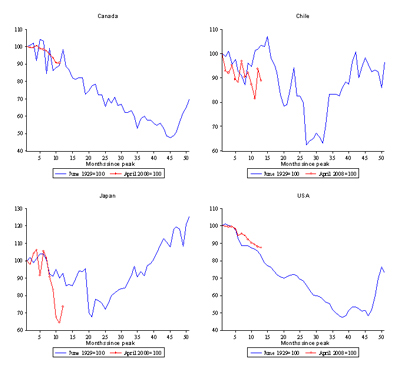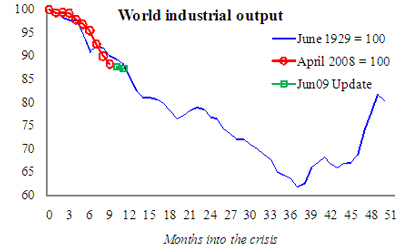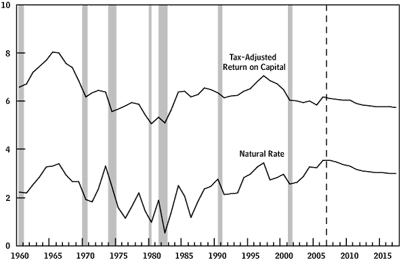Here’s another good reason to avoid working for a bank:
Treasury Secretary Timothy Geithner said federal bank regulators and the Securities and Exchange Commission will play key roles in the administration’s effort to change the way financial executives are paid.
Geithner said the Obama administration is moving ahead with its guidelines on corporate compensation, part of a broader plan for an overhaul of financial regulation that will be announced next week. Changes are needed so bank executives aren’t enticed to take on too much risk, he said.
You will note that regulators are the chosen method of enforcement, not ownership – so efforts to repay TARP funds will only go so far. It will be most interesting to see how this plays out … will the big banks start contracting out work they want done properly? Or will they embrace the Canadian cult of mediocrity?
DBRS today revised its methodology for Secured Leveraged Loans:
Under the revised policy, the result of any notch-up of the instrument rating for a high-yield issuer will be limited to an instrument rating of BBB (low), regardless of the level of the recovery rating that may have been assigned to the instrument.
In assigning ratings to leveraged finance (i.e., high-yield) issues, DBRS first assigns an issuer rating that reflects the default risk of the issuer itself, then assigns separate recovery ratings and instrument ratings to the issuer’s specific debt instruments. The instrument rating is a blend of both the issuer rating and the recovery rating and, therefore, may be notched up from the issuer rating in cases where the recovery rating reflects above-average post-default recovery prospects. Likewise, the instrument rating may be notched down in cases where the recovery rating reflects diminished recovery prospects.
The likelihood of default is more remote for investment-grade issuers, which is why DBRS only assigns recovery ratings to non-investment-grade issuers. The effect of this policy refinement is to lessen the weighting of recovery on the instrument ratings of non-investment-grade credits that are on the cusp of becoming investment grade. DBRS believes – and empirical data demonstrates – that default is a substantial possibility for issuers in the B category and below; therefore, the recovery outlook should weigh relatively heavily on the instrument rating. As a company moves through the BB range and approaches investment grade, the likelihood of default is significantly less, and it is appropriate to restrict the beneficial impact of the recovery rating on the final instrument rating outcome.
This resulted in changes of rating for Sears MTNs:
In Sears Canada’s case, the Company was originally assigned an issuer rating of BB. However, based on DBRS’s recovery analysis, expected recovery is 90% to 100% for the MTN holders in a post-default scenario. This level of recovery equates to a recovery rating of RR1 and an MTN rating of BBB, or three notches above the issuer rating (see the DBRS rating report dated September 19, 2008).
In reviewing our leveraged finance methodology, DBRS noted that as a company moves through the BB rating range and approaches investment grade, the likelihood of default is significantly less; therefore, DBRS felt it appropriate to restrict the beneficial impact of the recovery rating on the final instrument rating outcome. Thus, the effect of this policy refinement is to lessen the weighting of recovery on the instrument ratings of non-investment-grade credits that are on the cusp of becoming investment grade.
The revised leveraged finance methodology has therefore capped Sears Canada’s MTN rating at BBB (low), two notches above the issuer rating.
… and Domtar:
Domtar was originally assigned (and maintains) an Issuer Rating of BB. However, based on DBRS’s recovery analysis, the Secured debt was assigned a recovery rating of RR1, which assumes an expected recovery of 90% to 100% in a post-default scenario. The RR1 equated to a Secured rating of BBB, or three notches above the issuer rating (see rating report dated May 12, 2009).
In reviewing our leveraged finance methodology, DBRS noted that as a company moves through the BB rating range and approaches investment grade, the likelihood of default is significantly lower. Therefore, DBRS felt it appropriate to restrict the beneficial impact of the recovery rating on the final instrument rating outcome. The effect of this policy refinement is to lessen the weighting of recovery on the instrument ratings of credits that are on the cusp between investment grade and non-investment grade.
The revised leveraged finance methodology has therefore capped Domtar’s Secured rating at BBB (low), which is effectively a two-notch upgrade above the issuer rating.
Connor Clark has announced:
the closing of the initial public offering of Canadian Banc Capital Securities Trust (“Canadian Banc” or the “Fund”). The Fund raised gross proceeds of $96,289,000 from the issuance of 3,600,000 Class A Units and 251,560 Class F Units (collectively the “Units”) at a price of $25.00 per Unit.
Excuse me for living, but this product looks completely insane to me. Expenses are:
- 5.25% New issue selling commission on the Class A units. (one-time)
- About maybe 0.7% issue expenses (one-time)
- Management fee of 0.50%
- Service fee of 0.40% on Class A units
- 0.35% Counterparty fee
- Ongoing expenses of 0.15%
Amortizing the issue expenses over the five year life of the fund and assuming all units are Class A gives you an MER of 2.45%. The counterparty fee is there because the fund is structured to pay the income as return of capital / capital gains.
And all for what? A FIVE YEAR investment in PERPETUAL SECURITIES. That fact alone makes my hackles rise; you can just bet it’s being sold to Granny as a five year investment. They justify this in the prospectus by using pretend-maturities:
The Portfolio Manager uses the first date upon which the securities may be called at par (rather than the legal maturity) in order to calculate duration. Based on this approach, the duration of the Indicative Portfolio is approximately 6.4 years.
The preferred share market had another strong day today, as FixedResets continued their march towards a zero percent yield-to-call!
| HIMIPref™ Preferred Indices These values reflect the December 2008 revision of the HIMIPref™ Indices Values are provisional and are finalized monthly |
|||||||
| Index | Mean Current Yield (at bid) |
Median YTW |
Median Average Trading Value |
Median Mod Dur (YTW) |
Issues | Day’s Perf. | Index Value |
| Ratchet | 0.00 % | 0.00 % | 0 | 0.00 | 0 | 0.1701 % | 1,315.6 |
| FixedFloater | 7.02 % | 5.54 % | 30,356 | 16.23 | 1 | 2.6490 % | 2,150.2 |
| Floater | 2.87 % | 3.30 % | 86,548 | 18.91 | 3 | 0.1701 % | 1,643.6 |
| OpRet | 4.99 % | 3.79 % | 136,773 | 2.54 | 14 | 0.0993 % | 2,175.7 |
| SplitShare | 5.82 % | 6.32 % | 55,642 | 4.25 | 3 | 1.6132 % | 1,874.0 |
| Interest-Bearing | 5.99 % | 7.53 % | 25,248 | 0.54 | 1 | 0.0000 % | 1,989.2 |
| Perpetual-Premium | 0.00 % | 0.00 % | 0 | 0.00 | 0 | 0.1958 % | 1,734.7 |
| Perpetual-Discount | 6.33 % | 6.34 % | 163,038 | 13.46 | 71 | 0.1958 % | 1,597.7 |
| FixedReset | 5.68 % | 4.80 % | 562,427 | 4.36 | 39 | 0.1791 % | 2,008.7 |
| Performance Highlights | |||
| Issue | Index | Change | Notes |
| MFC.PR.C | Perpetual-Discount | -1.40 % | YTW SCENARIO Maturity Type : Limit Maturity Maturity Date : 2039-06-09 Maturity Price : 17.57 Evaluated at bid price : 17.57 Bid-YTW : 6.44 % |
| POW.PR.C | Perpetual-Discount | -1.21 % | YTW SCENARIO Maturity Type : Limit Maturity Maturity Date : 2039-06-09 Maturity Price : 21.97 Evaluated at bid price : 21.97 Bid-YTW : 6.73 % |
| BAM.PR.M | Perpetual-Discount | 1.35 % | YTW SCENARIO Maturity Type : Limit Maturity Maturity Date : 2039-06-09 Maturity Price : 15.81 Evaluated at bid price : 15.81 Bid-YTW : 7.71 % |
| PWF.PR.I | Perpetual-Discount | 1.42 % | YTW SCENARIO Maturity Type : Limit Maturity Maturity Date : 2039-06-09 Maturity Price : 22.63 Evaluated at bid price : 22.85 Bid-YTW : 6.66 % |
| RY.PR.W | Perpetual-Discount | 1.52 % | YTW SCENARIO Maturity Type : Limit Maturity Maturity Date : 2039-06-09 Maturity Price : 20.06 Evaluated at bid price : 20.06 Bid-YTW : 6.17 % |
| GWO.PR.J | FixedReset | 1.56 % | YTW SCENARIO Maturity Type : Call Maturity Date : 2014-01-30 Maturity Price : 25.00 Evaluated at bid price : 26.10 Bid-YTW : 4.88 % |
| BAM.PR.N | Perpetual-Discount | 1.57 % | YTW SCENARIO Maturity Type : Limit Maturity Maturity Date : 2039-06-09 Maturity Price : 15.55 Evaluated at bid price : 15.55 Bid-YTW : 7.84 % |
| CM.PR.P | Perpetual-Discount | 1.57 % | YTW SCENARIO Maturity Type : Limit Maturity Maturity Date : 2039-06-09 Maturity Price : 21.69 Evaluated at bid price : 21.97 Bid-YTW : 6.34 % |
| GWO.PR.I | Perpetual-Discount | 1.95 % | YTW SCENARIO Maturity Type : Limit Maturity Maturity Date : 2039-06-09 Maturity Price : 17.75 Evaluated at bid price : 17.75 Bid-YTW : 6.36 % |
| POW.PR.D | Perpetual-Discount | 2.03 % | YTW SCENARIO Maturity Type : Limit Maturity Maturity Date : 2039-06-09 Maturity Price : 19.13 Evaluated at bid price : 19.13 Bid-YTW : 6.66 % |
| BAM.PR.G | FixedFloater | 2.65 % | YTW SCENARIO Maturity Type : Limit Maturity Maturity Date : 2039-06-09 Maturity Price : 25.00 Evaluated at bid price : 15.50 Bid-YTW : 5.54 % |
| BNA.PR.C | SplitShare | 6.89 % | Asset coverage of 1.9-:1 as of May 29 according to the company. YTW SCENARIO Maturity Type : Hard Maturity Maturity Date : 2019-01-10 Maturity Price : 25.00 Evaluated at bid price : 15.51 Bid-YTW : 10.89 % |
| Volume Highlights | |||
| Issue | Index | Shares Traded |
Notes |
| BAM.PR.P | FixedReset | 268,697 | Recent new issue. YTW SCENARIO Maturity Type : Call Maturity Date : 2014-10-30 Maturity Price : 25.00 Evaluated at bid price : 25.38 Bid-YTW : 6.74 % |
| MFC.PR.E | FixedReset | 103,352 | Recent new issue. YTW SCENARIO Maturity Type : Call Maturity Date : 2014-10-19 Maturity Price : 25.00 Evaluated at bid price : 25.18 Bid-YTW : 5.51 % |
| BNS.PR.P | FixedReset | 72,452 | RBC crossed 60,500 at 25.25. YTW SCENARIO Maturity Type : Limit Maturity Maturity Date : 2039-06-09 Maturity Price : 25.10 Evaluated at bid price : 25.15 Bid-YTW : 4.80 % |
| RY.PR.D | Perpetual-Discount | 61,662 | YTW SCENARIO Maturity Type : Limit Maturity Maturity Date : 2039-06-09 Maturity Price : 18.45 Evaluated at bid price : 18.45 Bid-YTW : 6.17 % |
| BNS.PR.T | FixedReset | 56,900 | RBC crossed 46,500 at 27.18. YTW SCENARIO Maturity Type : Call Maturity Date : 2014-05-25 Maturity Price : 25.00 Evaluated at bid price : 27.13 Bid-YTW : 4.54 % |
| CM.PR.M | FixedReset | 43,600 | National Bank crossed 25,000 at 27.15. YTW SCENARIO Maturity Type : Call Maturity Date : 2014-08-30 Maturity Price : 25.00 Evaluated at bid price : 27.22 Bid-YTW : 4.98 % |
| There were 46 other index-included issues trading in excess of 10,000 shares. | |||


